Page 207 of 388
Downloaded from www.Manualslib.com manuals search engine Engine Overheating
You will find a coolant temperature gage on your
Chevrolet’s instrument panel.
You may also find a low
coolant warning light on your Chevrolet’s instrument
panel.
If Steam Is Coming From Your Engine
NOTICE:
If your engine catches fire because you keep
driving with
no coolant, your vehicle can be .
badly damaged. The costly repairs would not be
covered by your warranty.
Page 235 of 388
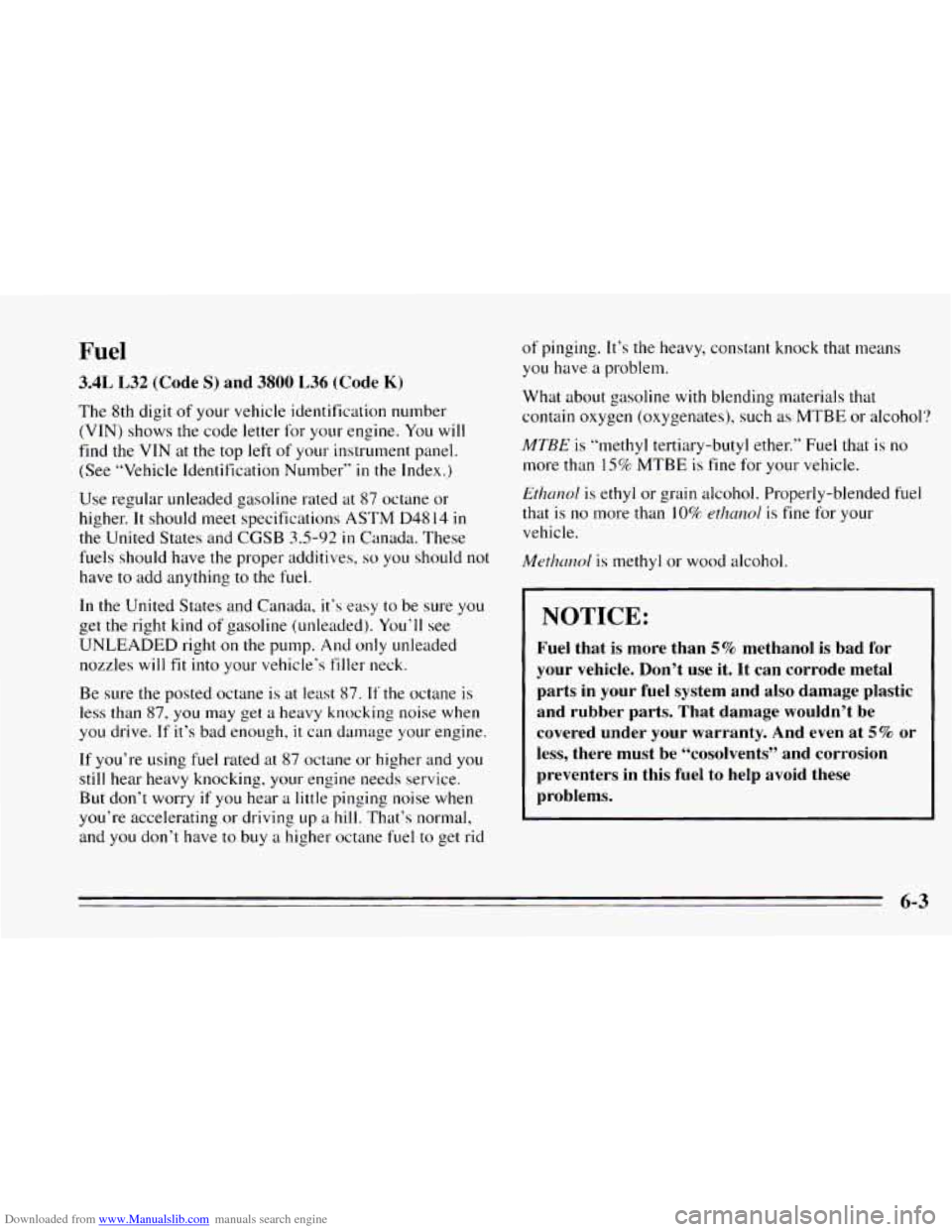
Downloaded from www.Manualslib.com manuals search engine Fuel
3.4L L32 (Code S) and 3800 L36 (Code K)
The 8th digit of your vehicl,e identification number
(VIN) shows the code letter for your engine. You will
find the
VIN at the top left of your instrument panel.
(See “Vehicle Identification Number”
in the Index.)
Use regular unleaded gasoline rated at
87 octane or
higher.
It should meet specifications ASTM D4814 in
the United States and CGSB 3.5-92 in Canada. These
fuels should have the proper additives,
so you should not
have to add anything to the fuel.
In the United States and Canada, it‘s easy to be sure you
get
the right kind of gasoline (unleaded). You’ll see
UNLEADED right on the pump, And only unleaded
nozzles will
fit into your vehicle‘s filler neck.
Be sure the posted octane is at least
87. If‘ the octane is
less than
87, you may get a heavy knocking noise when
you drive. If it’s bad enough, it can damage your engine.
If you’re using fuel rated at
87 octane or higher and you
still hear heavy knocking, your engine needs service.
But don’t worry
if you hear a little pinging noise when
you’re accelerating or driving up
a hill. That’s normal,
and
you don’t have to buy a higher octane fuel to get rid of
pinging. It’s the heavy, constant knock that means
you have a problem.
What about gasoline
with blending materials that
contain oxygen (oxygenates), such as
MTBE or alcohol?
MTBE is “methyl tertiary-butyl ether.” Fuel that is no
more than
15% MTBE is fine for your vehicle.
Etl?mol is ethyl or grain alcohol. Properly-blended fuel
that is no more than 10%
ethuuol is fine for your
vehicle.
Metlwrnof is methyl or wood alcohol.
NOTICE:
Fuel that is more than 5% methanol is bad for
your vehicle. Don’t use it.
It can corrode metal
parts in your fuel system and also damage plastic
and rubber parts. That damage wouldn’t be
covered under your warranty. And even at
5% or
less, there must be “co~oIvent~’’ and corrosion
preventers in this fuel to help avoid these
problems.
6-3
Page 236 of 388
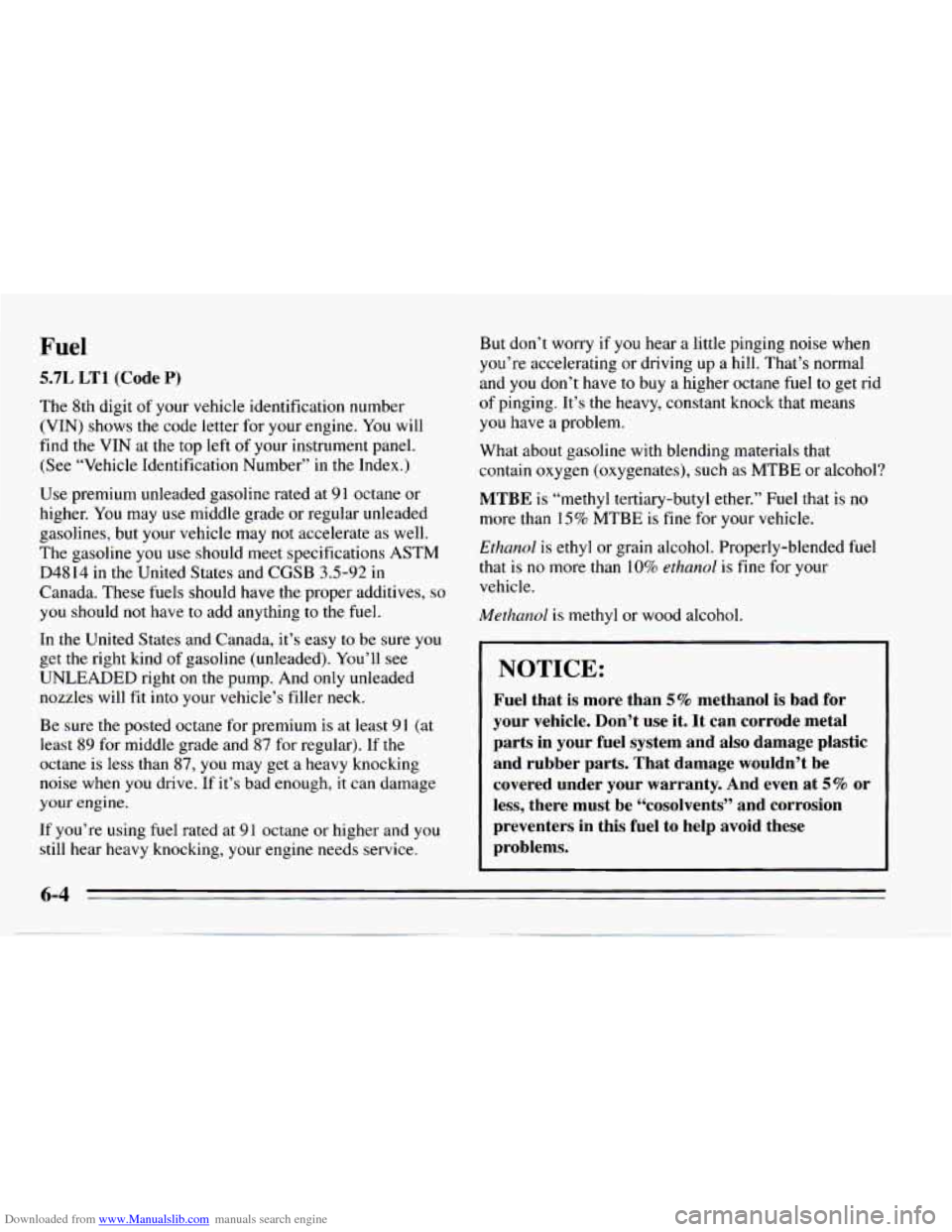
Downloaded from www.Manualslib.com manuals search engine Fuel
5.7L LT1 (Code P)
The 8th digit of your vehicle identification number
(VIN) shows the code letter for your engine.
You will
find the
VIN at the top left of your instrument panel.
(See “Vehicle Identification Number” in the Index.)
Use premium unleaded gasoline rated at
91 octane or
higher.
You may use middle grade or regular unleaded
gasolines, but your vehicle may
not accelerate as well.
The gasoline you use should meet specifications ASTM
D4814 in the United States and
CGSB 3.5-92 in
Canada. These fuels should have the proper additives,
so
you should not have to add anything to the fuel.
In the United States and Canada, it’s easy to be sure you
get the right kind of gasoline (unleaded). You’ll see
UNLEADED right on the pump. And
only unleaded
nozzles will fit into your vehicle’s filler neck.
Be sure the posted octane for premium is at least
9 I (at
least
89 for middle grade and 87 for regular). If the
octane is less than
87, you may get a heavy knocking
noise when
you drive. If it’s bad enough, it can damage
your engine.
If you’re using fuel rated at
9 1 octane or higher and you
still hear heavy knocking, your engine needs service. But don’t worry
if
you hear a little pinging noise when
you’re accelerating or driving up
a hill. That’s normal
and
you don’t have to buy a higher octane fuel to get rid
of pinging.
It’s the heavy, constant knock that means
you have a problem.
What about gasoline with blending materials that
contain oxygen (oxygenates), such as MTBE or alcohol?
MTBE is “methyl tertiary-butyl ether.’’ Fuel that is no
more than 15% MTBE is fine for your vehicle.
Ethanol is ethyl or grain alcohol. Properly-blended fuel
that
is no more than 10% ethanol is fine for your
vehicle.
Methanol is methyl or wood alcohol.
I NOTICE:
Fuel that is more than 5% methanol is bad for
your vehicle. Don’t use it. It can corrode metal parts in your fuel system and also damage plastic
and rubber parts. That damage wouldn’t be
covered under your warranty. And even at
5% or
less, there must be “cosolvents” and corrosion
preventers in this fuel to help avoid these
problems.
6-4
Page 243 of 388
Downloaded from www.Manualslib.com manuals search engine Then just pull the hood down and close it firmly.
Before closing
the hood, be sure
all the filler caps are
on.
Engine Oil
LOW blL
If the “LOW OIL” light on the instrument panel comes
on, it means you need to check your engine oil level
right away. For more information, see “Low Oil”
in the
Index. You should check your engine oil level regularly;
this is an added reminder.
It’s
a good idea to check your engine oil every time you
get
fuel. In order to get an accurate reading, the oil must
be warm and the vehicle must be on level ground.
6-11
Page 293 of 388
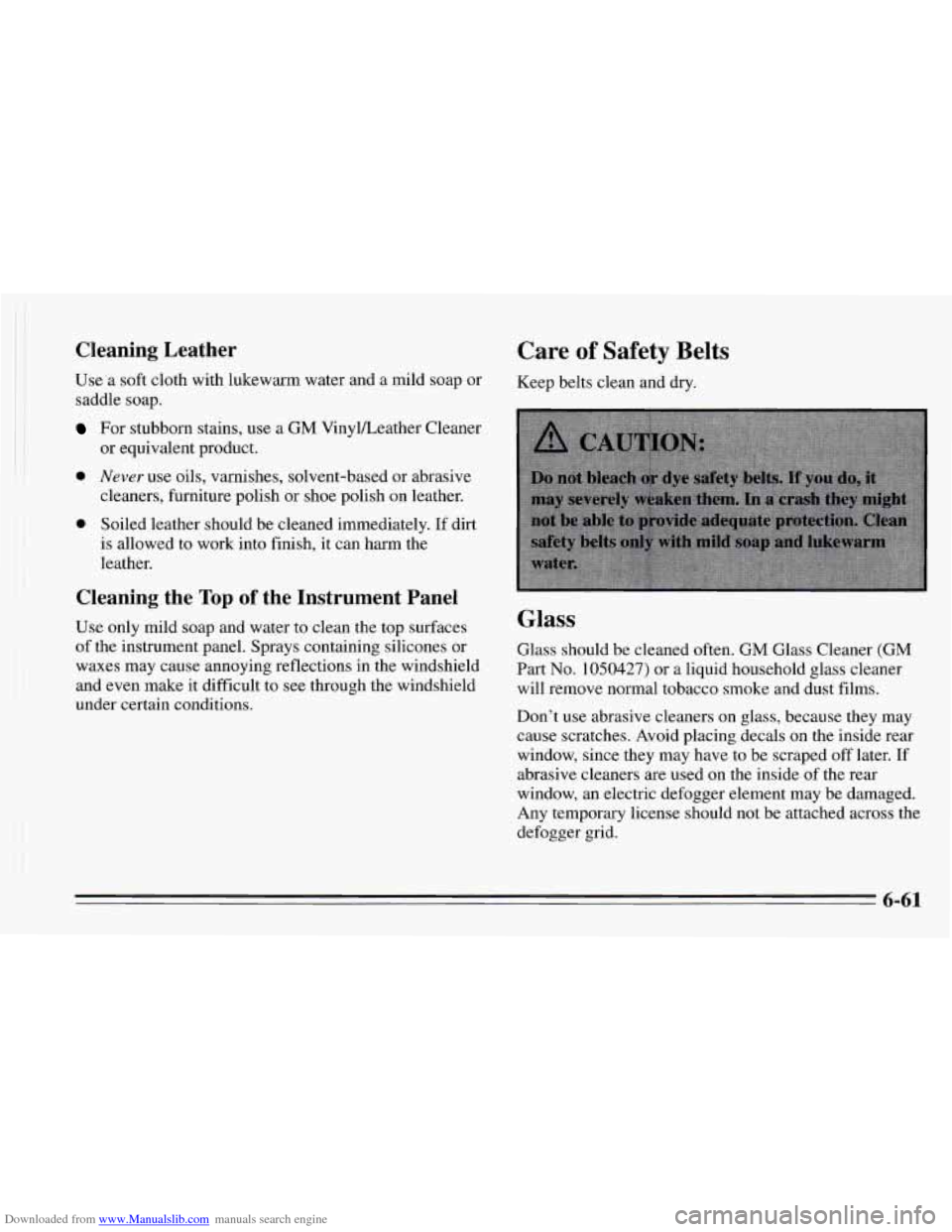
Downloaded from www.Manualslib.com manuals search engine I
I
Cleaning Leather
Use a soft cloth with lukewarm water and a mild soap or
saddle soap.
For stubborn stains, use a GM Vinylkeather Cleaner
or equivalent product.
0 Never use oils, varnishes, solvent-based or abrasive
cleaners, furniture polish or shoe polish on leather.
0 Soiled leather should be cleaned immediately. If dirt
is allowed to work into finish, it can harm the
leather.
Cleaning the Top of the Instrument Panel
Use only mild soap and water to clean the top surfaces of the instrument panel. Sprays containing silicones or
waxes may cause annoying reflections in the windshield
and even make it difficult to see through the windshield
under certain conditions.
Care of Safety Belts
Keep belts clean and dry.
Glass
Glass should be cleaned often. GM Glass Cleaner (GM
Part
No. 1050427) or a liquid household glass cleaner
will remove normal tobacco smoke and dust films.
Don’t use abrasive cleaners on glass, because they may
cause scratches. Avoid placing decals on the inside rear
window, since they may have to be scraped
off later. If
abrasive cleaners are used
on the inside of the rear
window, an electric defogger element may be damaged.
Any temporary license should not be attached across the
defogger grid.
6-61
Page 299 of 388
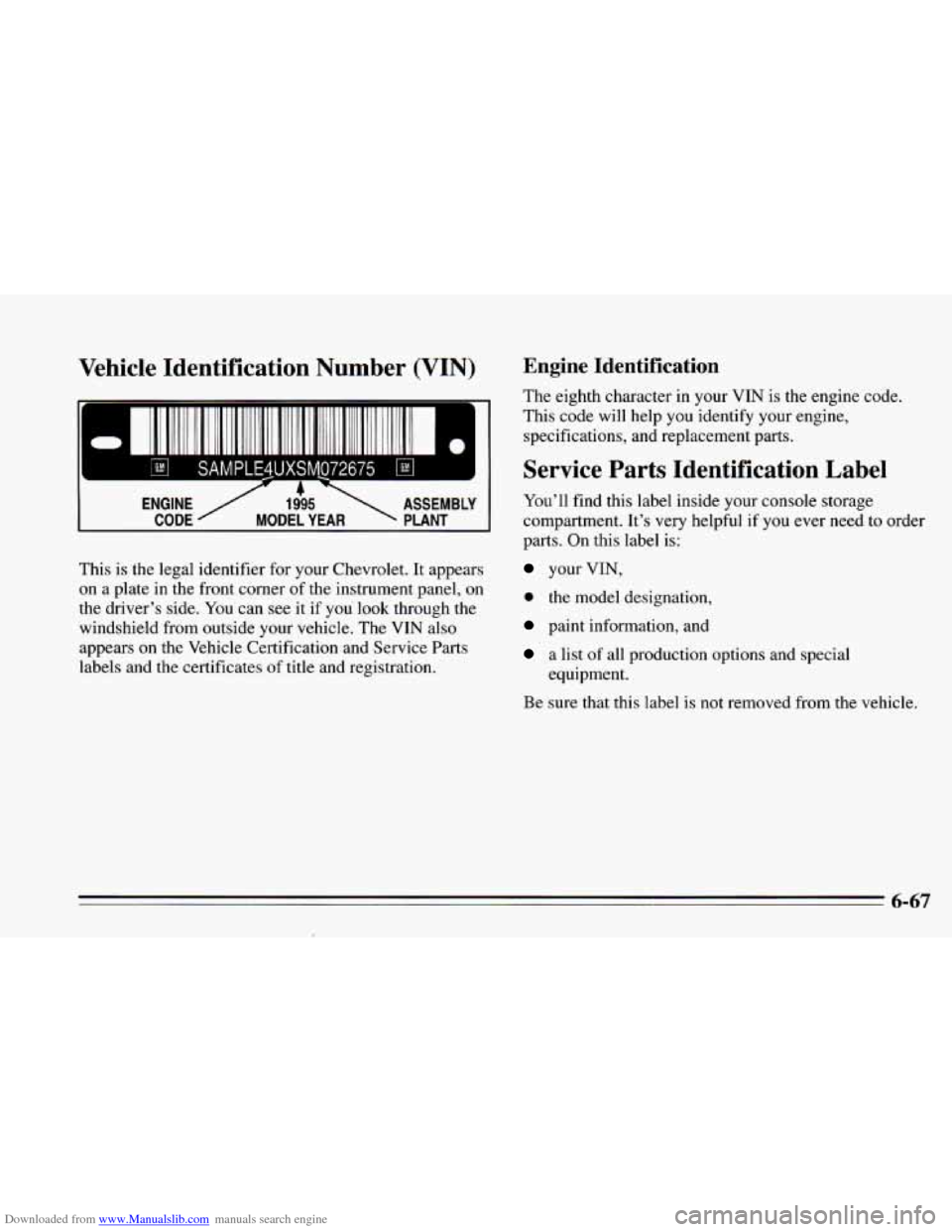
Downloaded from www.Manualslib.com manuals search engine Vehicle Identification Number (VIN)
r
1111 111111I IIII 11111111IIIIIIII IIIIIllll11111I1111111111Ill I IllIIIII
I #
ENGINE /
’gg5 PLANT
CODE MODEL YEAR ASSEMBLY
This
is the legal identifier for your Chevrolet. It appears
on a plate in the front corner of the instrument panel, on
the driver’s side. You can see it if you look through the
windshield from outside your vehicle.
The VIN also
appears on the Vehicle Certification and Service Parts
labels and the certificates
of title and registration.
Engine Identification
The eighth character in your VIN is the engine code.
This code will help you identify your engine,
specifications, and replacement parts.
Service Parts Identification Label
You’ll find this label inside your console storage
compartment. It’s very helpful
if you ever need to order
parts. On this label
is:
your VIN,
0 the model designation,
paint information, and
a list of all production options and special
equipment.
Be sure that this label
is not removed from the vehicle.
6-67
Page 300 of 388
Downloaded from www.Manualslib.com manuals search engine Add-on Electrical Equipment Fuses and Circuit Breakers
~ NOTICE: i
’ Don’t add anything electrical to your Chevrolet
unless you check with your dealer first. Some
electrical equipment can damage your vehicle
and the damage wouldn’t be covered by your
warranty. Some add-on electrical equipment can
keep other components from working as they
should.
Your vehicle has an air bag system. Before attempting to
add anything electrical to your Chevrolet, see “Servicing
Your Air Bag-Equipped Chevrolet” in the Index.
The wiring circuits in your vehicle are protected from
short circuits by a combination of fuses, circuit breakers,
and fusible thermal links in the wiring itself. This
greatly reduces the chance of fires caused by electrical
problems.
There are two fuse centers
on your vehicle. One is in the
left side
of your instrument panel.
6-68
Page 364 of 388
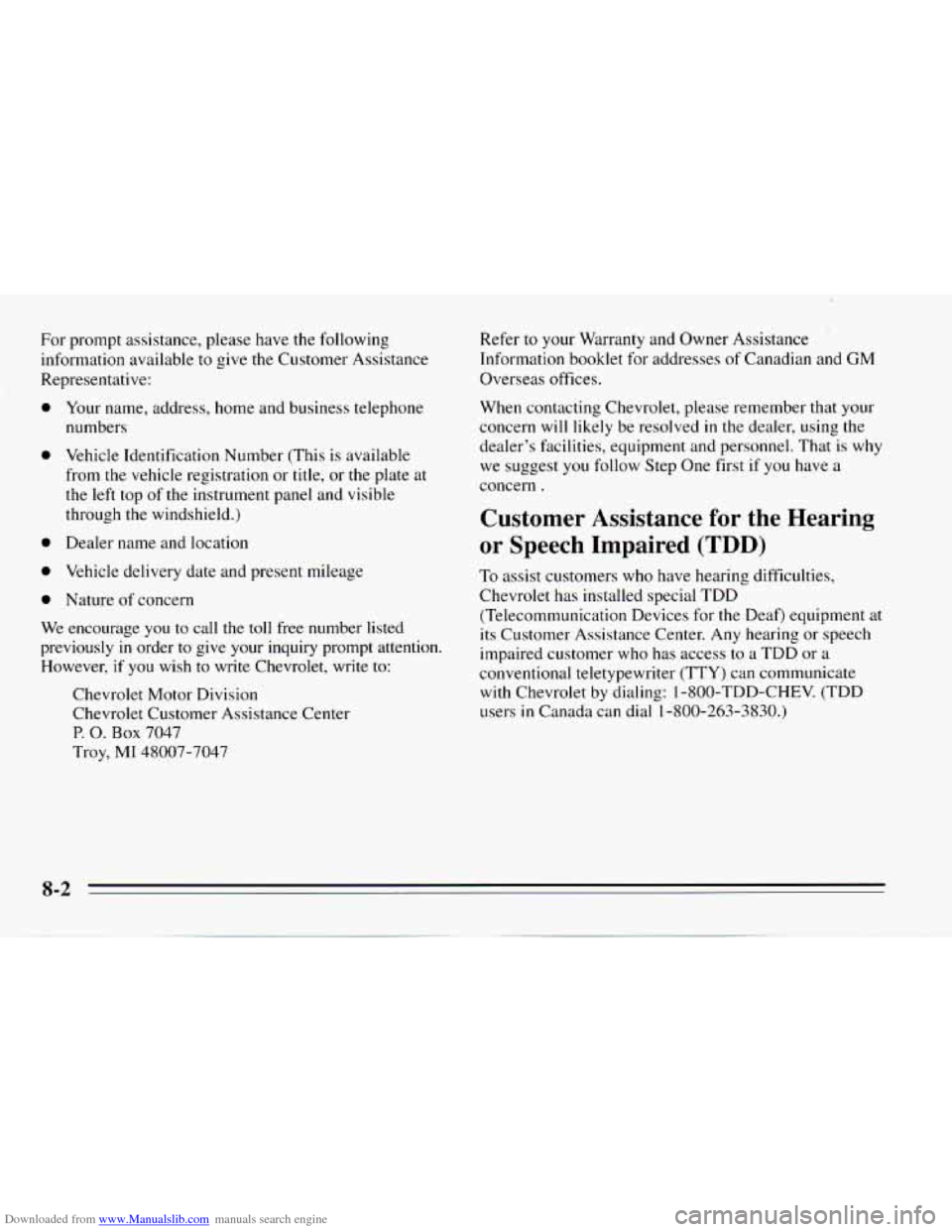
Downloaded from www.Manualslib.com manuals search engine For prompt assistance, please have the following
information available to give the Customer Assistance
Representative:
0
0
0
0
0
Your name, address, home and business telephone
numbers
Vehicle Identification Number (This is available
from
the vehicle registration or title, or the plate at
the
left top of the instrument panel and visible
through the windshield.)
Dealer name and location
Vehicle delivery date and present mileage
Nature
of concern
We encourage you to call the toll free number listed
previously in order to give your inquiry prompt attention. However, if you wish
to write Chevrolet, write to:
Chevrolet Motor Division
Chevrolet Customer Assistance Center
P. 0. Box 7047
Troy, MI
48007-7047
Refer to your Warranty and Owner Assistance '
Information booklet for addresses of Canadian and GM
Overseas offices.
When contacting Chevrolet, please remember that your
concern will likely be resolved
in the dealer, using the
dealer's facilities, equipment and personnel. That
is why
we suggest you follow Step One first if you have
a
concern .
Customer Assistance for the Hearing
or Speech Impaired
(TDD)
To assist customers who have hearing difficulties,
Chevrolet has installed special TDD
(Telecommunication Devices for the Deaf) equipment at
its Customer Assistance Center. Any hearing or speech
impaired customer who has access to a TDD or
a
conventional teletypewriter (TTY) can communicate
with Chevrolet by dialing:
1 -800-TDD-CHEV. (TDD
users
in Canada can dial 1-800-263-3830.)